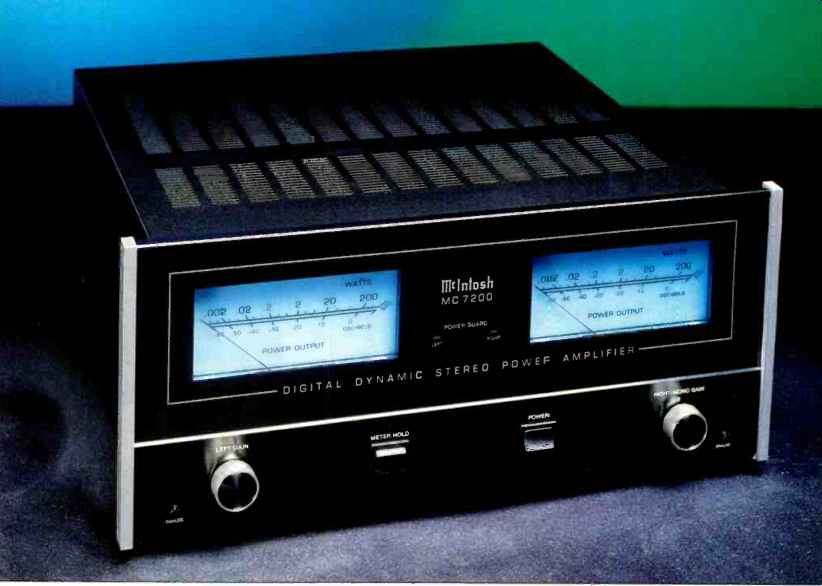
Manufacturer's Specifications:
Power Output: Stereo, 200 watts/ channel across 8 ohms or 300 watts/ channel across 4 ohms, 20 Hz to 20 kHz, both channels driven; bridged mono, 600 watts across 8 ohms, 20 Hz to 20 kHz.
THD: 0.005%, stereo or bridged mono, from 250 mW to rated power per channel.
SMPTE IM: 0.005% for any combination of frequencies from 20 Hz to 20 kHz.
Frequency Response: 20 Hz to 20 kHz, +0,-0.25 dB; 10 Hz to 100 kHz, +0,-3.0 dB. S/N: 105 dB below rated output (A-weighted). Damping Factor: Greater than 200. Input Impedance: 20 kilohms unbalanced, 40 kilohms balanced.
Input Sensitivity: Switchable, 1.4 or 2.5 V.
Power Guard: Clipping prevented and THD held below 2% with up to 20-dB overdrive at 1 kHz.
Power Requirements: 120 V a.c., 50/60 Hz, 0.6 to 15 amperes.
Dimensions: Chassis, 14 3/4 in. W x 7 1/2 in. H x 15 3/8 in. D (37.5 cm x 18.1 cm x 39.7 cm); front panel, 16 1/8 in. W x 7 1/8 in. H (41.1 cm x 18.1 cm).
Weight: 53 lbs. (24 kg).
Price: $2,595.
Company Address: 2 Chambers St., Binghamton, N.Y. 13903, USA.
It's been a long time since I last tested a piece of McIntosh equipment, and I was delighted when this massive (and heavy) high-powered amplifier was delivered to my lab. While other domestic and foreign manufacturers come and go, McIntosh, located in upper New York state, seems to go on forever. Although the company introduces new products far less frequently than most other audio component producers, when "Mac" does come up with a new product, you can bet that it's been designed with the same conservative approach, ruggedness, and reliability this company has always been known for.
The MC 7200 is a stereo power amplifier designed to operate with loudspeakers having a nominal load impedance of 8 or 4 ohms. Both balanced and unbalanced inputs are provided. The amplifier design provides nearly perfect linear operation, without loop feedback, for every stage of voltage or current amplification. According to the preliminary instruction manual supplied with my sample, this is accomplished by several techniques, including careful selection of each transistor used, light loading of each stage by its following stage, and higher, more linear input impedances of stages (made possible by using emitter degeneration). In addition, careful selection of resistors and capacitors in the signal path and the use of matched output transistors that have uniform current gain, high current-gain bandwidth product, low output capacitance, and large active-region safe operating areas help to eliminate any crossover distortion normally associated with high-efficiency amplifier designs.
There are no fewer than six protection circuits in the MC 7200. Power Guard, which I have seen in earlier McIntosh components, eliminates amplifier clipping caused by overdrive. In this circuit, the output waveform is compared with the input waveform. When a waveform difference develops due to the onset of clipping, Power Guard indicators light and an electronic attenuator at the amplifier input reduces overall gain. Another circuit, Sentry Monitor, constantly monitors the output signal and reacts to prevent overload of the output transistors. Thermal, sensors within the MC 7200 will interrupt a.c. power if temperatures become excessive. A turn-on delay of about 2 S prevents any pops or thumps from annoying the listener or damaging loudspeakers. Another protection circuit prevents speaker damage caused by d.c. in the output signal; should the circuit detect d.c. in either channel's output, it will clamp the power supply to zero, causing the fuse in the MC 7200 to blow. The sixth protection circuit guards against power-line transient surges.
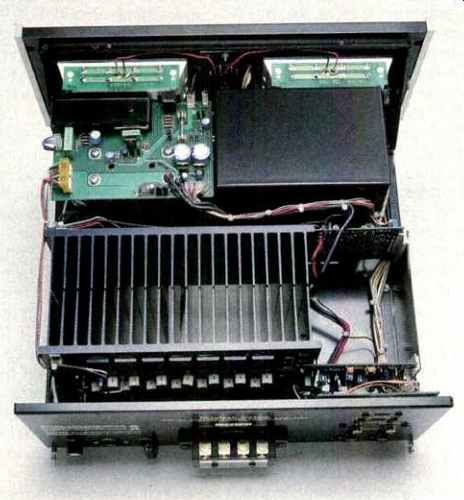

Like all McIntosh components, the MC 7200 comes with the necessary hardware and template for custom mounting in a cabinet, using the company's well-known Panloc installation system. This allows you to lock the unit firmly in place while still being able to unlock and remove it easily. The procedure is not difficult, as I've found in earlier tests. If you prefer shelf or table-top mounting, McIntosh also offers component cabinets to fit all of their products.
Circuit Description
Each MC 7200 amplifier channel uses two stages of voltage amplification followed by three stages of current amplification. The input signal feeds one input of a differential amplifier stage. Negative feedback from the amplifier output is applied to the other input. The differential amplifier outputs connect to current-mirror stages and feed a positive-drive cascode voltage-amplifier stage. The cascode amplifier feeds complementary Darlington driver transistors; these supply the signal to 14 complementary-connected output transistors. The chassis is arranged for convection cooling and requires no mechanical fan to maintain proper operating temperature. The power supply uses a massive power transformer, full-wave bridge rectifiers, and large filter capacitors having 100 joules of energy storage. Two large heat-sinks cool the 28 output transistors.
Control Layout
Two large illuminated power output meters on the front panel are calibrated in both watts and decibels. The meters' logarithmic calibration permits you to read from 200 watts down to 0.002 watt. The meters respond to the peak output of each channel; when amplifying musical signals that might be too "fast" for the mechanical pointer to follow, a special circuit provides a "time stretched" electrical pulse so that the peak position of the pointer can be observed by the human eye. Furthermore, the meter can be locked at the peak indication by selecting a "Meter Hold" switch just to the left of the panel's center line. The "Power" on/off switch is symmetrically postioned just to the right of that line.
Whenever the Power Guard circuit limits the output to prevent clipping, left- and right-channel lights on the front panel turn on to let you know that the amplifier is being overdriven. Left- and right-channel gain controls complete the front panel layout; when using the amplifier in the bridged mono mode, only the right-channel gain control is active.
The rear panel has three types of input jacks-pairs of XLR connectors and quarter-inch phone jacks for balanced lines, and RCA-type phono jacks for unbalanced inputs.
McIntosh has come up with clever speaker terminals that accept either heavy-gauge wire (up to AWG #4) or spade lugs; when spade lugs are not used, the connector screws must be replaced with other screws, which are supplied separately in a small bag. All elements of the speaker terminals that come in contact with the speaker wires, including the special screws, are gold-plated. Recessed slide switches on the rear panel select input sensitivity (1.4 or 2.5 V) and stereo or bridged mono operation. When the bridged mode is selected, a single speaker is connected between the two "hot" terminals, with no connection made to the "common" or ground terminals. Under these circumstances, a single input is applied to the balanced or unbalanced right input on the rear panel.
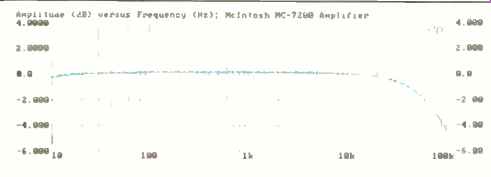
Fig. 1-Frequency response measured at 2 watts output into 8-ohm loads.
Note that response was virtually identical for both channels.
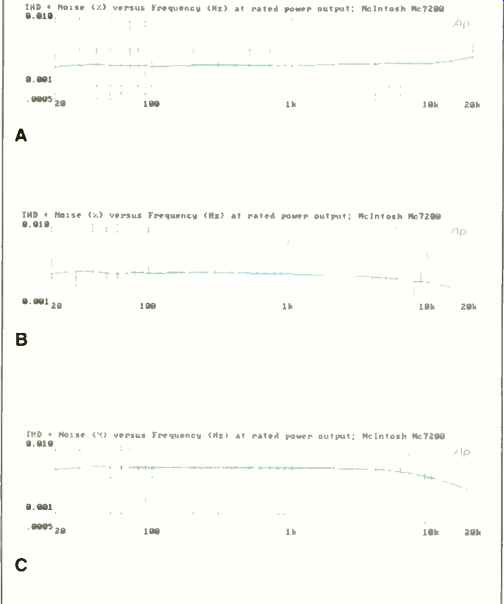
Fig. 2-THD + N vs. frequency at rated output levels of 200 watts per channel
into 8 ohms (A), 300 watts per channel into 4 ohms (B), and 600 watts bridged
mono into 8 ohms (C).
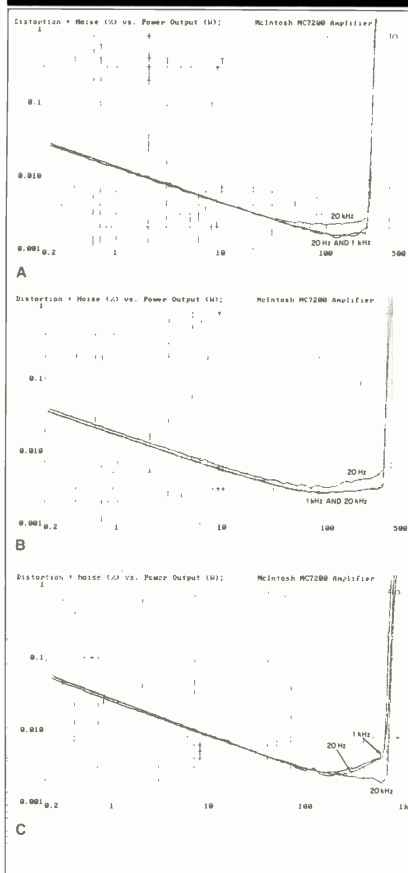
Fig. 3-THD + N vs. power output for stereo operation into loads of 8 ohms
(A) and 4 ohms (B) and for bridged mono operation into 8 ohms (C).
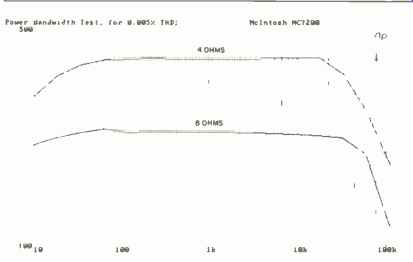
Fig. 4--Power bandwidth for rated THD level of 0.005%.
Measurements
Frequency response of the MC 7200 amplifier, for 2 watts output, is shown in Fig. 1. Response was down less than 0.2 dB at 20 kHz and down about 0.1 dB at 20 Hz. The gain of both channels was virtually identical. The high-frequency -3 dB roll-off point occurred at around 80 kHz; at 100 kHz, response was down 4.2 dB. When McIntosh decided to let me test this amplifier, I received a letter from their chief engineer, Sidney Corderman, whom I have known for many years. He warned me that I would probably not be able to obtain distortion values down to the levels that he had measured for this amplifier.
Corderman told me that he had used a Panasonic VP-7722P analyzer, which, he said, is one of the few instruments capable of measuring the ultra-low distortion levels produced by this amp. I took this with a grain of salt, having acquired the Audio Precision System One test system some time ago. Well, I must confess that my test equipment has met its match-and then some. How do I know? Because Corderman supplied his own test data for this amplifier, and his graph of THD versus frequency showed a THD reading of under 0.001% over most of the audio range, when driving 8-ohm loads to a constant output level of 200 watts per channel. The best I could get, as shown in Fig. 2A, was a reading of just under 0.002% for the same test conditions.
There was a slight rise in THD + N, to 0.0025%, at 20 kHz. I hasten to add, however, that my readings are the sum of THD + N, whereas Corderman's were for THD only. In the not-too-distant future, I expect to be able to read THD figures as low as my friend up in Binghamton can-once I get the digital signal processing upgrade installed in my Audio Precision gear, which will allow me to use narrow band filtering when I analyze harmonic distortion. Meanwhile, let's not quibble over the difference between 0.001% and 0.002%. For all I know, I may be reading the residual distortion of my test setup's signal generator.
The same test was repeated for 4-ohm stereo and 8-ohm bridged mono operation, at 300 and 600 watts per channel, respectively; results are shown in Figs. 2B and 2C. In Fig. 3, I plotted THD + N versus power output. As usual, although readings seem higher at low output levels than at high ones, this is the result of noise and not harmonic distortion. At or near the rated output levels on these graphs (200 watts for Fig. 3A, 300 watts for Fig. 3B, and 600 watts for Fig. 3C), results correlated fairly well with those shown in Figs. 2A, 2B, and 2C. Since McIntosh specifies power bandwidth (the frequency range over which full power can be maintained at rated THD or less), I ran some tests to confirm this specification.
(Normally, I omit this test, preferring instead to measure dynamic headroom in accordance with the EIA Amplifier Measurement Standards.) Figure 4 shows the power levels that can be obtained at various frequencies for a fixed, specified THD level of 0.005%. In the case of 8-ohm loads, that power level was about 230 watts per channel for nearly all of the audible frequency range. When I used 4-ohm loads, the amplifier delivered about 400 watts per channel at all but the extreme bass and treble frequencies. This should give you some idea of how conservatively McIntosh rates their products! The only test results that did not conform to McIntosh's claims were those for SMPTE-IM distortion, shown for stereo operation into 8and 4-ohm loads (Fig. 5A) and for bridged mono operation into 8-ohm loads (Fig. 5B). I suspect that this small discrepancy may be mostly due to noise and/or ground loops in my setup. Even with that, the readings I obtained for the equivalent of rated output (after compensating for the test waveform) are hardly anything to be concerned about. In stereo operation, I measured 0.006% at 200 watts into 8-ohm loads and 0.022% at 300 watts into 4-ohm loads; in bridged mode, I got 0.021% at 600 watts into 8 ohms.
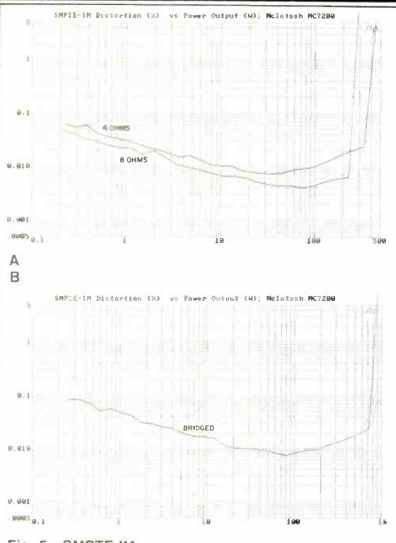
Fig. 5--SMPTE-IM distortion vs. power output for stereo operation (A)
and for bridged mono operation into 8 ohms (B).
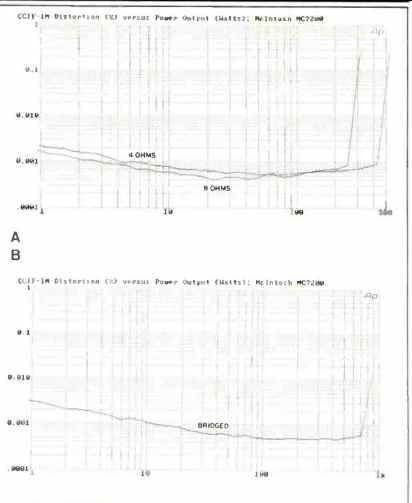
Fig. 6--CCIF-IM distortion vs. power output for stereo operation (A) and
for bridged mono operation into 8 ohms (B).
I had much better luck when I tested CCIF-IM distortion, which essentially measures the "beat" 1-kHz frequency present at the output of an amplifier when two high-frequency signals are fed to the inputs at the same time. In the case of the McIntosh MC 7200, I applied equal amplitude signals at 18 and 19 kHz (Figs. 6A and 6B). At the rated output levels for the three operating conditions, COIF IM was only 0.0007% at 200 watts into 8 ohms and at 300 watts into 4 ohms and was 0.00052% at 600 watts into 8 ohms in bridged mono mode.
Damping factor, referred to 8-ohm loads and using a 50 Hz test signal, measured 235, well above the minimum of 200 claimed by McIntosh. The A-weighted S/N ratio was 85 dB below 1 watt. Translated to a reference level of rated output (200 watts per channel into 8 ohms), this works out to an S/N ratio of 108 dB-again, better than the 105 dB claimed by the manufacturer. Using 8-ohm loads, dynamic headroom amounted to 2.1 dB, which means that for short musical peaks of 20 mS or so, this amplifier can deliver nearly 325 watts per channel into 8-ohm loads. With 4-ohm loads, the dynamic headroom was even greater, measuring nearly 2.5 dB.
Use and Listening Tests
Because this amplifier has gain controls, I was able to connect my reference CD player directly to the MC 7200. To have done otherwise would have meant using a preamplifier whose characteristics may not have been as good as those of the amp I was trying to judge. At almost the same time I started to test this amplifier, some new Delos releases arrived in my lab. One of these, Organ Works by Ned Rorem (Delos D/CD-3076), was perfect for putting this amp through its paces, what with the powerful, sonorous tones that the Marcussen organ at Wichita State University in Kansas produced. The MC 7200 never seemed strained, nor was there ever a time when the Power Guard lights illuminated.
Although not all of this organ music suited my taste, it certainly was a good disc for testing a high-powered, low distortion amplifier such as this.
Once I had satisfied myself that the "Mac" could handle the peaks and complex sounds of the organ, I turned to another recent Delos release that features, among other works by Haydn, his Symphony No. 51 in B-Flat Major (Delos DE-3064). This recording may not have made as severe demands on the MC 7200, but it certainly offered a soothing respite after all the bench testing. All of which proves that a superbly designed amplifier such as the McIntosh MC 7200 delivers good sound, whatever the type of music.
-Leonard Feldman
( Audio magazine, Jan. 1990 )
Also see:
Mcintosh MCD-7009 CD Player (Jan. 1996)
McIntosh MC2600 Amplifier (Feb. 1992)
McIntosh Model C-27 Stereo Preamplifier (Sept. 1978)
Mcintosh MC500 Amp and C40 Preamp (Auricle, Jan. 1995)
= = = =